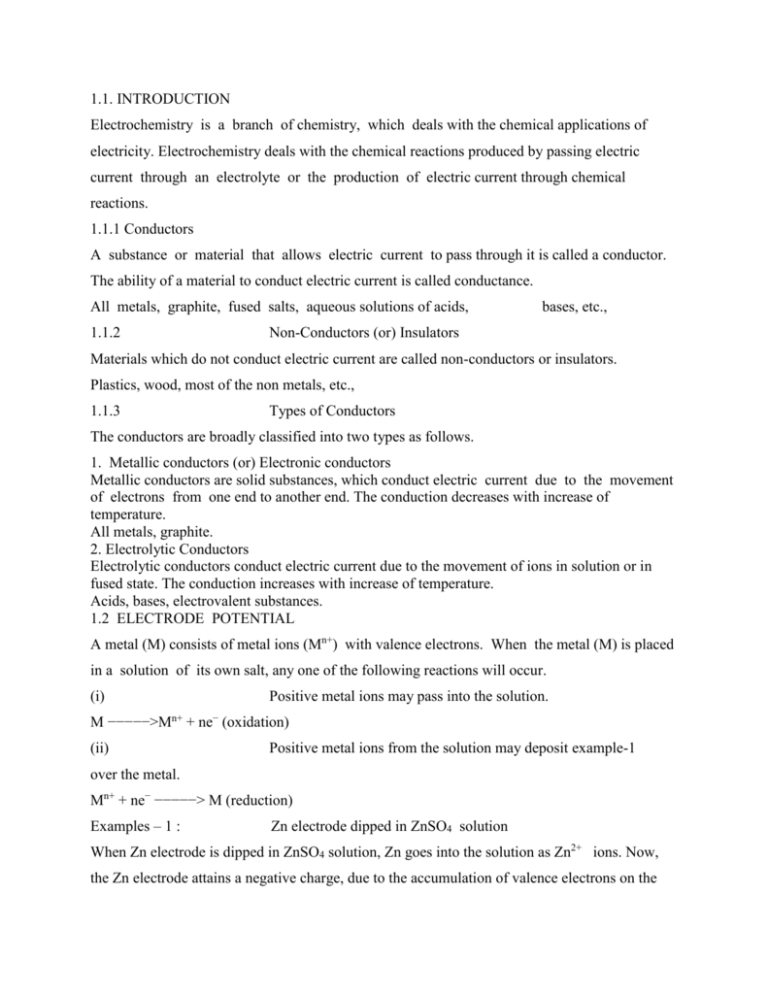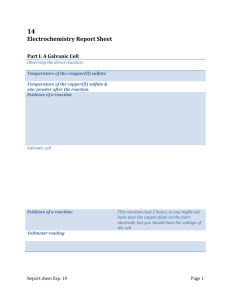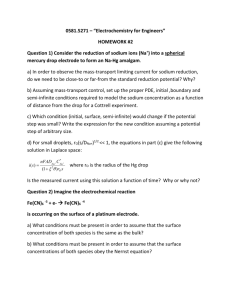2 Cu electrode dipped in CuSO 4 solution
advertisement

1.1. INTRODUCTION Electrochemistry is a branch of chemistry, which deals with the chemical applications of electricity. Electrochemistry deals with the chemical reactions produced by passing electric current through an electrolyte or the production of electric current through chemical reactions. 1.1.1 Conductors A substance or material that allows electric current to pass through it is called a conductor. The ability of a material to conduct electric current is called conductance. All metals, graphite, fused salts, aqueous solutions of acids, 1.1.2 bases, etc., Non-Conductors (or) Insulators Materials which do not conduct electric current are called non-conductors or insulators. Plastics, wood, most of the non metals, etc., 1.1.3 Types of Conductors The conductors are broadly classified into two types as follows. 1. Metallic conductors (or) Electronic conductors Metallic conductors are solid substances, which conduct electric current due to the movement of electrons from one end to another end. The conduction decreases with increase of temperature. All metals, graphite. 2. Electrolytic Conductors Electrolytic conductors conduct electric current due to the movement of ions in solution or in fused state. The conduction increases with increase of temperature. Acids, bases, electrovalent substances. 1.2 ELECTRODE POTENTIAL A metal (M) consists of metal ions (Mn+) with valence electrons. When the metal (M) is placed in a solution of its own salt, any one of the following reactions will occur. (i) Positive metal ions may pass into the solution. M −−−−−>Mn+ + ne− (oxidation) (ii) Positive metal ions from the solution may deposit example-1 over the metal. Mn+ + ne− −−−−−> M (reduction) Examples – 1 : Zn electrode dipped in ZnSO4 solution When Zn electrode is dipped in ZnSO4 solution, Zn goes into the solution as Zn2+ ions. Now, the Zn electrode attains a negative charge, due to the accumulation of valence electrons on the metal. The negative charges developed on the electrode attract the positive ions from solution. Due to this attraction the positive ions remain close to the metal. (Fig. 1.1.a) Example -2 Cu electrode dipped in CuSO4 solution When Cu electrode is dipped in CuSO4 solution, Cu2+ ions from the solution deposit over the metal. Now, the Cu electrode attains a positive charge, due to the accumulation of Cu2+ ions on the metal. The positive charges developed on the electrode attract the negative ions from solution. Due to this attraction, the negative ions remain close to the metal. (Fig. 1.1.b) Thus, a sort of layer (positive (or) negative ions) is formed all around the metal. This layer is called Helmholtz electrical double layer. This layer prevents further passing of the positive ions from or to the metal. A difference of potential is consequently set up between the metal and the solution. At equilibrium, the potential difference becomes a constant value, which is known as the electrode potential of a metal. Thus, the tendency of an electrode to lose electrons is called the oxidation potential, and the tendency of an electrode to gain electrons is called the reduction potential. Factors affecting electrode potential The rate of the above reactions depend on i. The nature of the metal. ii. The temperature. iii. The concentration of metal ions in solution. 1.2.1Single electrode potential (E) It is the measure of tendency of a metallic electrode to lose or gain electrons, when it is in contact with a solution of its own salt. 1.2.2Standard electrode potential (E°) It is the measure of tendency of a metallic electrode to lose or gain electrons, when it is in contact with a solution of its own salt of 1 molar concentration at 25°C. 1.2.3Nernst equation for electrode potential Consider the following redox reaction Mn+ + ne− −−−−−>M For such a redox reversible reaction, the free energy change (∆G) and its equilibrium constant (K) are inter related as 1.2.1Single electrode potential (E) It is the measure of tendency of a metallic electrode to lose or gain electrons, when it is in contact with a solution of its own salt. 1.2.2 Standard electrode potential (E°) It is the measure of tendency of a metallic electrode to lose or gain electrons, when it is in contact with a solution of its own salt of 1 molar concentration at 25°C.






